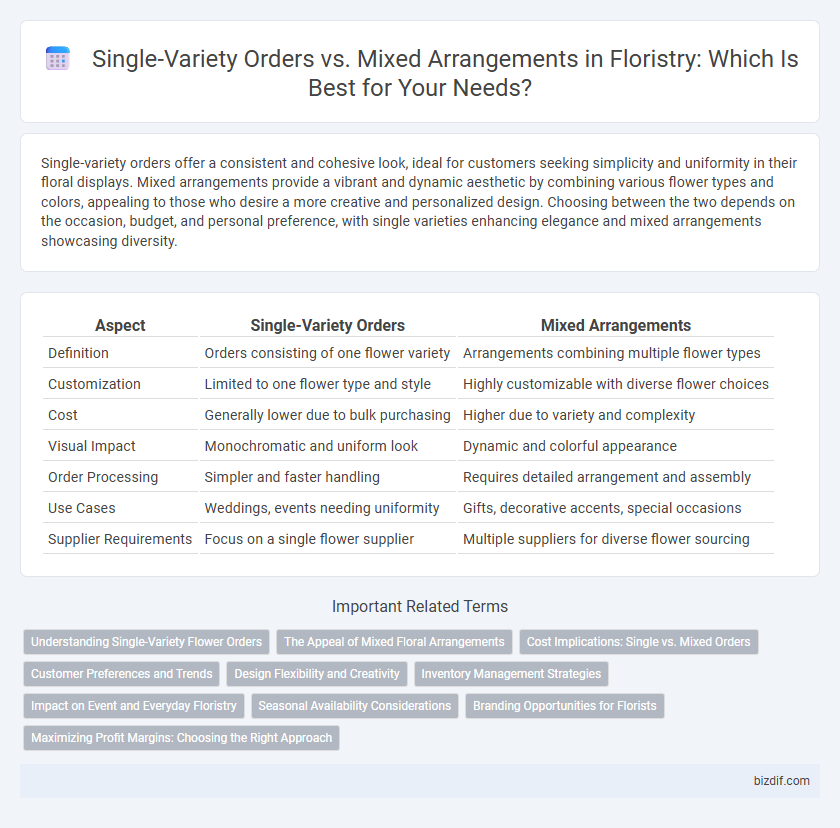Single-variety orders offer a consistent and cohesive look, ideal for customers seeking simplicity and uniformity in their floral displays. Mixed arrangements provide a vibrant and dynamic aesthetic by combining various flower types and colors, appealing to those who desire a more creative and personalized design. Choosing between the two depends on the occasion, budget, and personal preference, with single varieties enhancing elegance and mixed arrangements showcasing diversity.
Table of Comparison
| Aspect | Single-Variety Orders | Mixed Arrangements |
|---|---|---|
| Definition | Orders consisting of one flower variety | Arrangements combining multiple flower types |
| Customization | Limited to one flower type and style | Highly customizable with diverse flower choices |
| Cost | Generally lower due to bulk purchasing | Higher due to variety and complexity |
| Visual Impact | Monochromatic and uniform look | Dynamic and colorful appearance |
| Order Processing | Simpler and faster handling | Requires detailed arrangement and assembly |
| Use Cases | Weddings, events needing uniformity | Gifts, decorative accents, special occasions |
| Supplier Requirements | Focus on a single flower supplier | Multiple suppliers for diverse flower sourcing |
Understanding Single-Variety Flower Orders
Single-variety flower orders emphasize uniformity, showcasing the beauty of one species or color to create a cohesive and elegant arrangement. These orders simplify inventory management and often appeal to clients seeking a minimalist or symbolic floral statement. Understanding customer preferences and occasions helps florists tailor single-variety bouquets, maximizing visual impact and satisfaction.
The Appeal of Mixed Floral Arrangements
Mixed floral arrangements captivate with their vibrant combination of colors, textures, and floral varieties, creating a dynamic and visually appealing display that single-variety orders often lack. The harmonious blend of complementary blooms enhances aesthetic depth and offers a tailored expression for diverse occasions and personal tastes. Florists leverage the versatility of mixed arrangements to deliver unique, customizable bouquets that elevate the overall sensory experience.
Cost Implications: Single vs. Mixed Orders
Single-variety floral orders typically lower costs by enabling bulk purchases of one flower type, reducing supplier complexity and waste. Mixed arrangements often increase expenses due to the need for multiple flower varieties, higher labor in design complexity, and sourcing from different suppliers. Budget-conscious florists balance the aesthetic appeal of mixed bouquets with the cost efficiency of single-variety blooms to optimize profitability.
Customer Preferences and Trends
Single-variety orders appeal to customers seeking simplicity and uniformity, often preferred for formal occasions or corporate events where cohesive aesthetics matter. Mixed arrangements attract clients looking for vibrant, dynamic designs that showcase seasonal variety and creativity, aligning with trends favoring personalized and expressive floral displays. Current consumer data indicates a growing interest in mixed bouquets due to their versatility and visual impact, although single-variety selections remain popular for minimalist and elegant themes.
Design Flexibility and Creativity
Single-variety orders provide a focused palette that allows florists to highlight the unique texture, color, and form of one flower type, maximizing design precision and thematic coherence. Mixed arrangements enhance creativity by combining diverse shapes, colors, and floral species, offering greater adaptability to client preferences and seasonal availability. Emphasizing design flexibility, mixed bouquets enable innovative patterns and layering techniques that are less achievable with single-variety compositions.
Inventory Management Strategies
Single-variety orders streamline inventory management by reducing the need for diverse flower stock, enabling more accurate demand forecasting and minimizing waste. Mixed arrangements require a broader inventory, increasing complexity in stock rotation and supplier coordination to maintain freshness and variety. Effective inventory strategies balance procurement schedules and storage conditions to optimize flower availability for both order types.
Impact on Event and Everyday Floristry
Single-variety orders deliver a cohesive and striking visual impact, enhancing event themes with uniform elegance often seen in weddings and corporate functions. Mixed arrangements offer versatility and vibrant color palettes suited for everyday floristry, appealing to customers seeking variety and natural diversity. Event florists favor single-variety blooms for stylistic consistency, while retail florists leverage mixed bouquets to maximize appeal and sales across diverse customer preferences.
Seasonal Availability Considerations
Single-variety orders offer a consistent aesthetic but depend heavily on the seasonal availability of that specific flower, which can limit options during off-peak periods. Mixed arrangements provide flexibility by incorporating a diverse selection of blooms that are seasonally abundant, ensuring freshness and cost-effectiveness. Florists must strategically balance these approaches to optimize flower quality and meet customer preferences throughout the year.
Branding Opportunities for Florists
Single-variety orders enhance brand consistency by showcasing a florist's expertise in a specific flower, creating a signature style that strengthens customer recognition. Mixed arrangements offer versatile branding opportunities by demonstrating creativity and the ability to customize designs, appealing to a broader audience. Leveraging both approaches allows florists to establish a distinctive market identity while meeting diverse client preferences effectively.
Maximizing Profit Margins: Choosing the Right Approach
Single-variety orders streamline inventory management and reduce waste, directly boosting profit margins through volume discounts and lower logistical costs. Mixed arrangements appeal to diverse customer preferences, allowing premium pricing on customized designs and increasing average order value. Carefully analyzing customer demand patterns and supplier pricing can optimize profitability by balancing standardization with creative variety.
Single-variety orders vs Mixed arrangements Infographic

 bizdif.com
bizdif.com